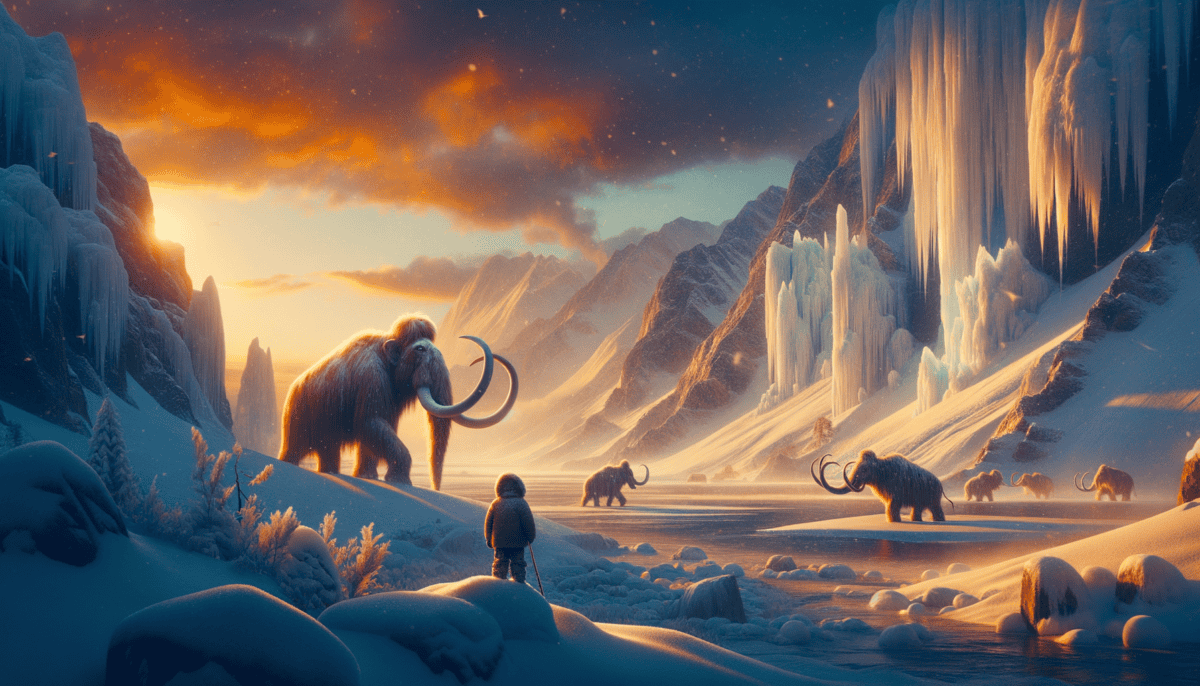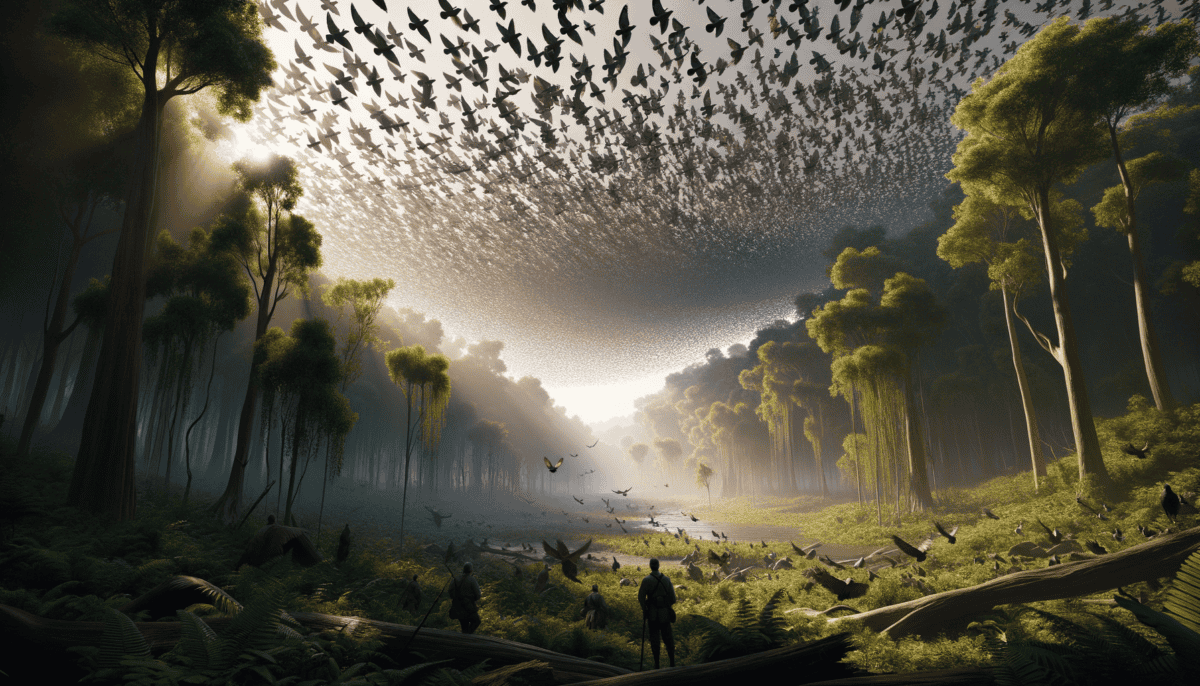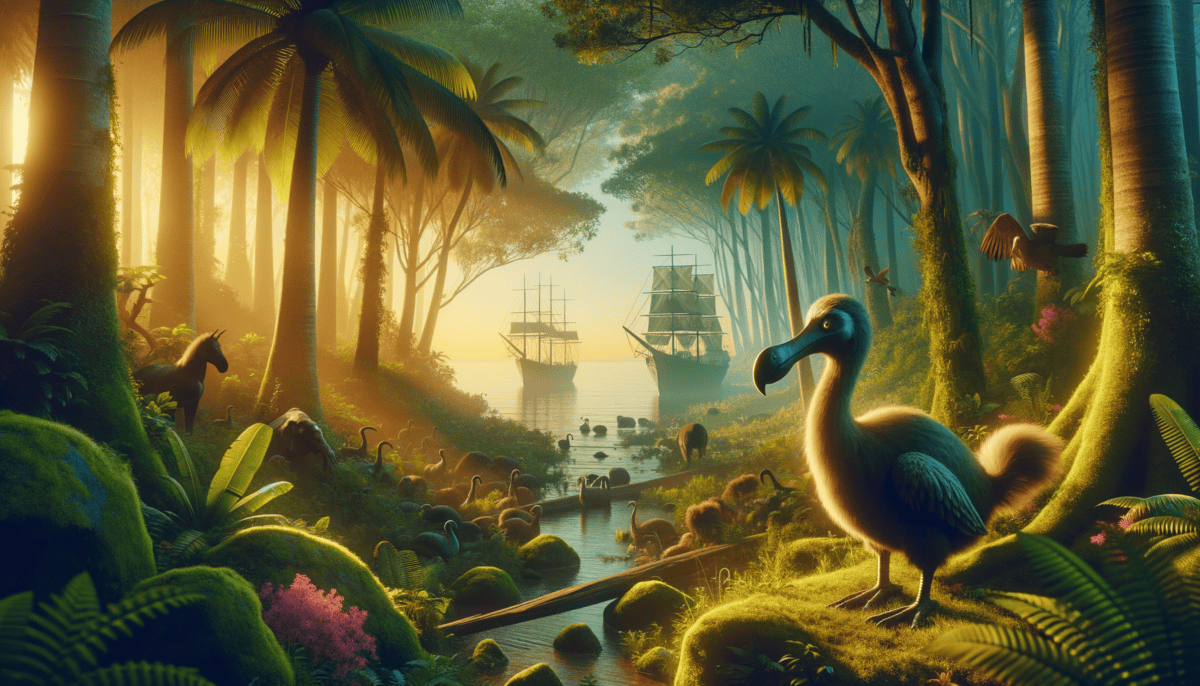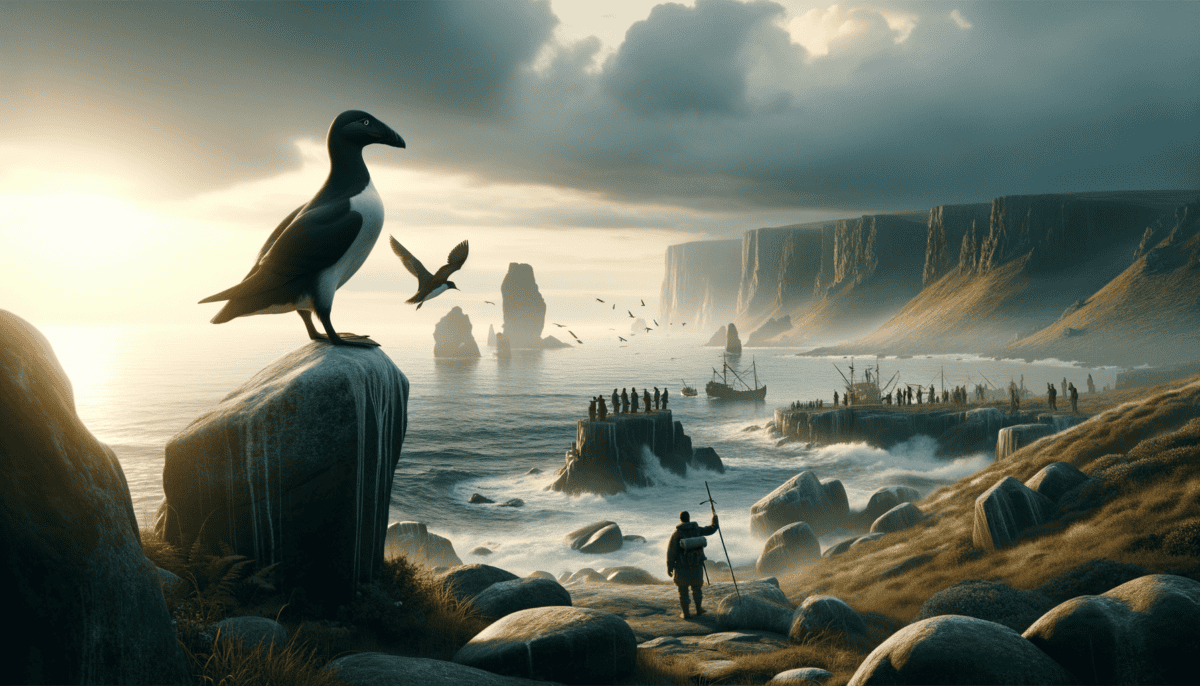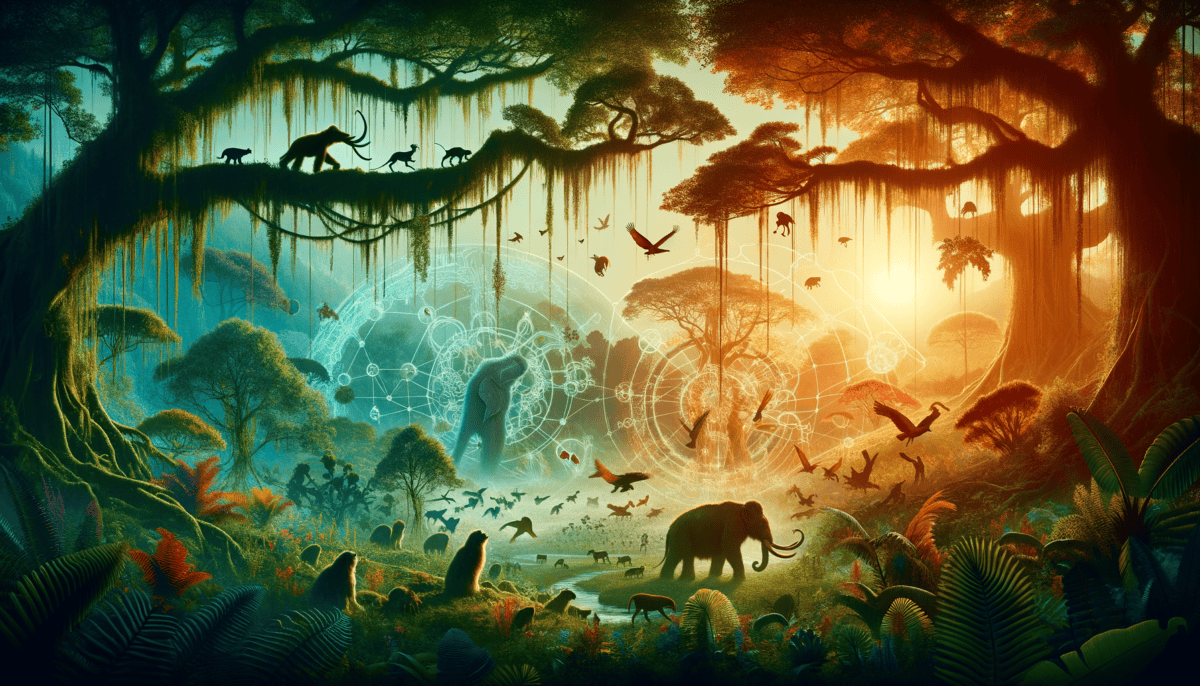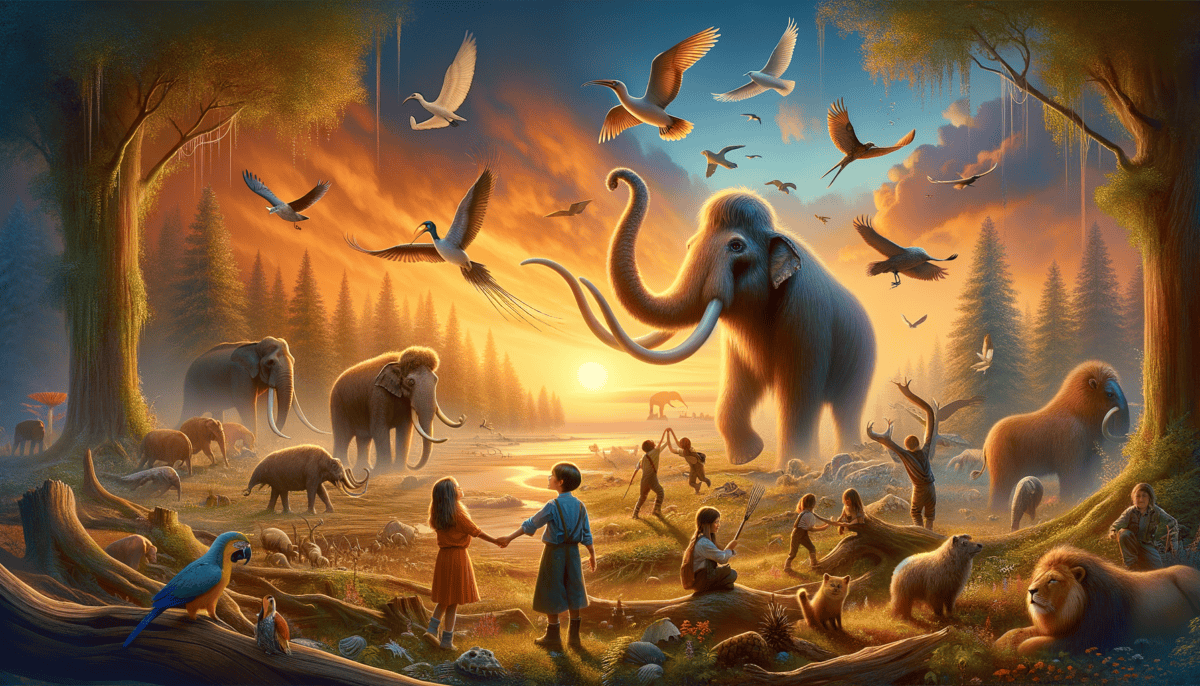The Vanishing World
Deep in the icy lands of long ago, where snow covered the ground like a thick white blanket, lived the mighty woolly mammoth. These giant animals looked a lot like elephants, but they wore warm, fuzzy coats to keep out the cold.
"Look at those huge tusks!" whispered Little Tuko to his father as they watched a family of mammoths trudge through the snow. The tusks curved like giant bananas, stretching longer than three kids standing on each other's shoulders.
The mammoth family moved slowly across the frozen ground. The biggest one, probably the mama mammoth, used her long trunk to brush away snow, looking for grass and plants to eat. Her baby stayed close, copying everything she did.
But something strange started happening in their world. The weather began to change. The ice that covered much of the land slowly melted away. Plants that mammoths loved to eat became harder to find.
"Where did all the grass go?" the baby mammoth trumpeted sadly to his mother. The changing world made it harder for the mammoth families to find enough food.
As the years passed, fewer and fewer mammoths roamed the land. The once-mighty herds that shook the ground with their footsteps became smaller and smaller.
People started seeing these amazing creatures less often. Like magic tricks gone wrong, the woolly mammoths seemed to be disappearing. This was something called "extinction" – when all of a type of animal dies out and is gone forever.
"But why did they disappear?" asked Little Tuko, his eyes wide with wonder.
His father pointed to the changing landscape around them. "Sometimes, when the world changes too fast, animals can't keep up. They need time to adapt – to change how they live. The mammoths couldn't change quickly enough."
Key things that made it hard for woolly mammoths to survive:
- The weather got warmer
- Their food became scarce
- The places they lived changed too much
- Humans hunted them for food
Today, we can only imagine what it was like to see these gentle giants walking across the land. Scientists find their bones buried deep in the ground, like puzzle pieces from the past. These bones tell us stories about how mammoths lived and help us understand why they disappeared.
Little Tuko sat quietly, thinking about the woolly mammoths. "I wish I could see one," he said softly.
"Me too," his father replied. "That's why it's so important to take care of the animals we have now. We don't want them to disappear like the mammoths did."
The sun set over the changed landscape, painting the sky in beautiful oranges and pinks. Somewhere in the distance, an elephant trumpeted – a sound not so different from the calls of their long-lost woolly cousins.
Wings of Memory
Sarah pressed her nose against the dusty glass case in the museum. Inside, a single bird stood frozen in time. Its feathers were a soft blue-gray, with a rosy pink chest.
“This is Martha,” the museum guide said softly. “She was the very last passenger pigeon in the whole world.”
“But how could they all be gone?” Sarah asked. “Were there only a few of them?”
The guide smiled sadly. “Actually, there used to be billions of them – more birds than you could count in your whole life! Let me tell you their story…”
Long ago, passenger pigeons ruled the skies over America. When they flew overhead, their wings made a sound like thunder. The flocks were so huge that they could take days to pass by.
“The birds were beautiful dancers in the sky,” explained the guide. “They would swoop and turn all together, like they were following a secret song that only they could hear.”
Sarah closed her eyes and imagined it:
Millions of wings beating against the blue sky
Feathers catching sunlight like tiny mirrors
The air filled with soft cooing sounds
But then people started to change the forests where the pigeons lived. They cut down the big trees where the birds made their nests. Hunters caught them in huge nets and sold them for food.
“Did anyone try to save them?” Sarah’s voice was barely a whisper.
“Some people did,” the guide answered. “But they didn’t realize how quickly the pigeons were disappearing. By the time they understood, it was too late.”
The last wild passenger pigeon was shot in 1900. After that, only a few remained in zoos. Martha was the very last one. She lived at the Cincinnati Zoo until September 1, 1914.
Things that made passenger pigeons special:
- They flew in massive flocks that darkened the sky
- They could fly very fast – about 60 miles per hour
- They helped spread tree seeds through the forest
- They were beautiful birds with colorful feathers
Sarah placed her hand against the glass. “I wish I could have seen them flying,” she said. “It must have been like magic.”
“It was,” the guide nodded. “And that’s why we need to protect the birds we have today. We don’t want any more empty glass cases in our museums.”
Outside the museum window, a group of pigeons pecked at breadcrumbs on the sidewalk. They weren’t passenger pigeons, but they reminded Sarah that every bird is special and worth protecting.
The afternoon sun cast long shadows through the museum windows, making Martha’s glass case glow like a treasure chest. In a way, that’s exactly what it was – a treasure chest holding memories of a bird that once ruled the American skies.
Island of the Dodo
The warm sea breeze ruffled Tommy’s hair as he stood on the beach of Mauritius. His family had traveled all the way to this beautiful island for vacation. But something was missing.
“Dad, is this where the dodo birds used to live?” Tommy asked, drawing a bird shape in the sand with his toe.
“That’s right, buddy,” his father replied. “Let’s visit the museum to learn more about them.”
Inside the museum, Tommy gasped at the life-sized dodo model. It was bigger than he expected, about as tall as his little sister!
“The dodo was a very special bird,” the museum curator explained. “It couldn’t fly, but it didn’t need to. It had everything it needed right here on Mauritius.”
Gentle giants with gray feathers
Waddling peacefully through the forest
Never afraid because they had no enemies
For thousands of years, the dodos lived happily on their island paradise. They built nests on the ground and ate fruits that fell from the trees. They had never seen humans before.
“What happened when people came to the island?” Tommy asked.
The curator’s face grew sad. “When sailors first arrived in 1598, everything changed for the dodos. The sailors brought animals that had never been on the island before.”
These are the things that made life hard for dodos:
- Rats ate their eggs
- Pigs destroyed their nests
- Sailors hunted them for food
- Their forest homes were cut down
“The poor dodos didn’t know how to protect themselves,” the curator continued. “They had never needed to before. They were too trusting.”
Tommy looked at the dodo model’s gentle face. “They must have been very friendly birds.”
“Yes, they were. Some sailors even called them ‘silly birds’ because they weren’t afraid of humans. But the dodos weren’t silly – they just never learned to be scared.”
Less than 100 years after humans first came to Mauritius, the last dodo disappeared forever. Nobody even realized it was happening until it was too late.
Outside the museum, Tommy and his family walked through a nature preserve. Beautiful birds sang in the trees – not dodos, but their distant cousins who still called Mauritius home.
“Dad,” Tommy said thoughtfully, “I think we need to be extra careful with the animals we have left. We don’t want any more to disappear like the dodo.”
The setting sun painted the sky in brilliant oranges and pinks. Somewhere in the forest, a bird called out – a reminder that while the dodo was gone, the island was still full of amazing creatures that needed protection.
Hunters and the Hunted
Tommy sat in his classroom, his mind still on the dodos from his Mauritius trip. His teacher, Ms. Garcia, was setting up a special presentation about animals that disappeared because of hunting.
“Today, we’re going to learn about the great auk,” Ms. Garcia announced, showing a picture of a black and white bird that looked a bit like a penguin.
“Wow, it’s so big!” Sarah exclaimed from the front row.
“Yes, they were about as tall as a second-grader,” Ms. Garcia smiled. “These amazing birds lived in the cold waters of the North Atlantic Ocean.”
The great auks were excellent swimmers. They could dive deep into the ocean to catch fish. On land, they waddled around like penguins do today.
Mighty swimmers in cold seas
Black and white feathers gleaming
Standing proud on rocky shores
“But if they were such good swimmers, what happened to them?” Tommy asked.
Ms. Garcia’s expression turned serious. “People hunted them for many things:”
- Their soft feathers for pillows and blankets
- Their meat for food
- Their eggs for eating
- Their fat for oil in lamps
“The great auks couldn’t escape easily on land,” Ms. Garcia explained. “They could only waddle slowly to their nesting spots on rocky islands.”
Tommy raised his hand again. “Did people know they were making the birds disappear forever?”
“At first, no. There were so many great auks that people thought they would never run out. But as the birds became harder to find, their value went up. Museums and collectors wanted to have the last ones.”
The class grew quiet, thinking about how something that seemed so endless could vanish.
“Today, we have laws to protect animals from too much hunting,” Ms. Garcia said. “We learned from mistakes like what happened to the great auk.”
She showed the class pictures of modern conservation efforts. Rangers protecting wildlife. Scientists studying endangered species. Kids learning about nature.
“Remember,” Ms. Garcia said, “every animal plays an important part in nature’s story. When we lose one, we lose a piece of our world’s puzzle.”
After class, Tommy drew a picture of a great auk swimming in the ocean. Next to it, he wrote: “Protected animals are happy animals.”
He thought about the dodos and the great auks. Both had trusted humans too much. Both had disappeared forever. But their stories taught important lessons about protecting the animals we still have.
That evening, Tommy watched seabirds flying over the beach near his home. He imagined what it would be like to see a great auk swimming in those waves. Even though he never would, he could help protect the birds that were still here.
Nature’s Delicate Balance
Tommy couldn’t stop thinking about all the animals that had disappeared. During recess, he sat under his favorite oak tree with his friend Sarah.
“It’s like a big puzzle,” Sarah said, watching a butterfly land on a nearby flower. “Every animal and plant fits together somehow.”
Just then, their science teacher Mr. Chen walked over. He had overheard them talking.
“You’re exactly right, Sarah! Would you like to see how everything connects?”
Mr. Chen led the class outside to the school garden. “Let’s play a game called ‘Nature’s Web,'” he said with a smile.
He gave each student a card with a picture:
- Flowers
- Bees
- Birds
- Trees
- Butterflies
- Soil
“Now, hold this string,” Mr. Chen said, giving one end to Tommy, who had the bee card. “Sarah, since you have the flower card, you’re connected to Tommy’s bee. Take the other end.”
One by one, they connected the string between students until they made a web.
“See how everyone’s connected? If one piece goes missing…”
Mr. Chen gently asked Maria, who held the butterfly card, to sit down. Part of the web sagged.
“When we lose butterflies,” he explained, “fewer flowers get pollinated. Then fewer seeds grow. Then birds have less food.”
Tommy remembered the passenger pigeons he’d learned about. “Is that what happened when all those pigeons disappeared?”
“Yes! When millions of pigeons vanished, the whole forest changed. The trees they ate from grew differently. The animals that depended on those trees had to adapt.”
Mr. Chen showed them pictures of success stories:
The California Condor soared back from just 27 birds to over 400 today!
Giant pandas in China are doing better because people protect their bamboo forests!
“What can we do to help?” Sarah asked eagerly.
“Plant flowers for bees and butterflies in your garden,” Mr. Chen suggested. “Use less plastic. Learn about endangered animals in your area.”
Tommy looked at the web of string they’d made. It reminded him of a safety net at a circus.
“We’re like nature’s safety net!” he exclaimed. “When we protect one animal, we’re really protecting lots of them!”
That afternoon, Tommy and Sarah started planning a butterfly garden for the school. They drew pictures of flowers and made a list of plants that butterflies love.
As they worked, a real butterfly danced past their window. Tommy smiled, knowing that every small thing they did could help keep nature’s web strong.
The next day, more students joined their garden project. Soon, they would have a special place where nature’s web could grow stronger, one flower at a time.
Guardians of the Future
One sunny morning, Tommy burst into class with exciting news. “Look what I found!” He held up a newspaper showing a black rhino baby.
“The zoo helped save these rhinos,” Tommy explained to his classmates. “They were almost gone, but now there are more!”
Mr. Chen smiled proudly. “That’s wonderful, Tommy! Who wants to be an animal guardian?”
Every hand shot up. Sarah jumped from her seat. “Can we start today?”
“We sure can!” Mr. Chen pulled out a big map. He marked spots where kids just like them were helping animals.
- Beach cleanup crews saving sea turtles
- Tree planting teams helping koalas
- Garden builders making homes for butterflies
- Bird watchers counting rare species
“Today, we become Animal Guardian Rangers!” Mr. Chen handed out special badges he’d made.
“Being a guardian means making choices that help animals every day.”
The class started their first mission right away. They turned their playground into an animal-friendly zone:
✨ They planted wildflowers for bees
✨ Built bird feeders from recycled materials
✨ Made signs to teach others about endangered animals
As weeks passed, amazing things happened. Butterflies danced in their garden. Birds made nests in their feeders. Even a family of rabbits moved in!
“Look!” Sarah pointed to a bee buzzing between flowers. “We did that. We helped make this happen!”
Tommy watched a hummingbird zip past. “It’s like we’re writing a new story,” he said. “One where animals don’t disappear anymore.”
Mr. Chen gathered the class for their graduation ceremony as Animal Guardian Rangers. “You’ve learned something very important,” he said. “Every animal needs a friend, and you can be that friend.”
That evening, Tommy walked home through their new wildlife garden. He saw butterflies, birds, and bees all living together. He remembered the sad stories of animals that disappeared long ago.
“But that won’t happen again,” he whispered. “Not while we’re here to help.”
And so, Tommy, Sarah, and their classmates discovered their power to make a difference. They learned that everyone – even kids – can help write a better future for all animals.
As the sun set, Tommy smiled at his Animal Guardian badge. He knew this wasn’t the end of their story – it was just the beginning of their greatest adventure.

